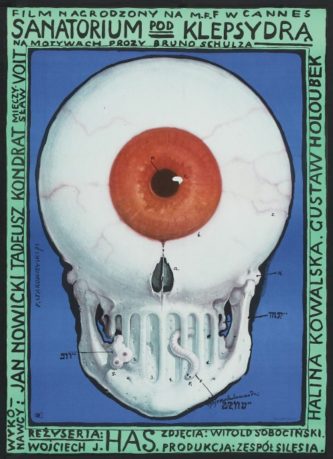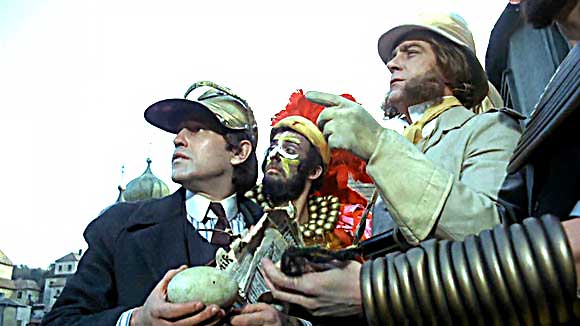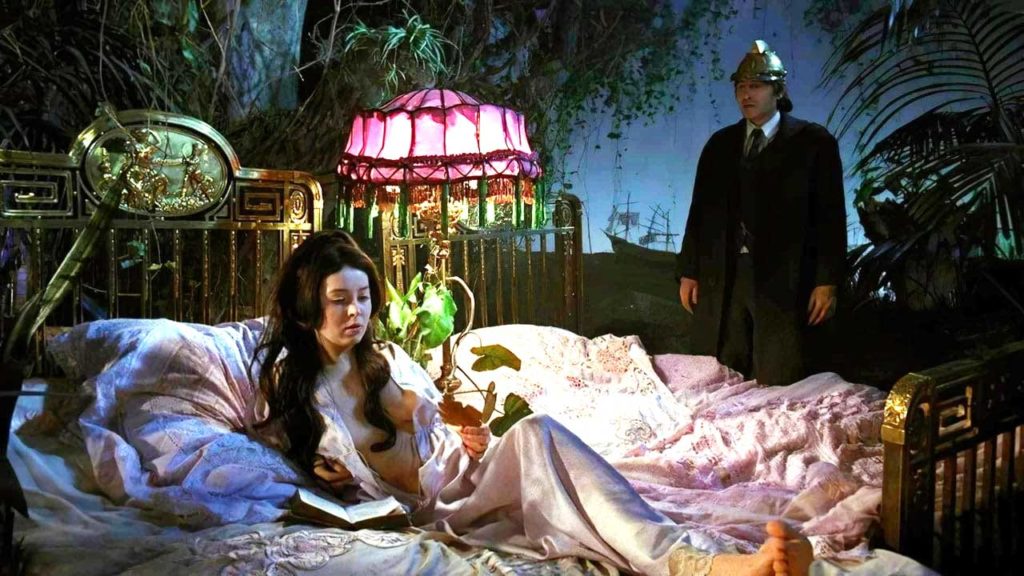 Although it’s little known, this Polish-made reverie is one of the screen’s great mindbenders. Surreal, confounding and macabre, it’s a gorgeous, superbly constructed and highly demanding film.
Although it’s little known, this Polish-made reverie is one of the screen’s great mindbenders. Surreal, confounding and macabre, it’s a gorgeous, superbly constructed and highly demanding film.
Surreal, confounding and macabre, it’s a gorgeous, superbly constructed and highly demanding film.
The Polish filmmaker Wojciech J. Has (1925-2000) was among the most skilled practitioners of surreal and fantastic cinema. His best known work remains THE SARAGOSSA MANUSCRIPT (1965), but he’s made many other unforgettable films, including THE DOLL (1968), MEMOIRS OF A SINNER (1986) and THE TRIBULATIONS OF BALTHAZAR KOBER (1988).
THE HOURGLASS SANATORIUM (SANATORIUM POD KLEPSYDRA), from 1973, was Has’s most expensive and ambitious production (it reportedly took five years to complete), and may well be his masterpiece. Like many of his films it was based on a famous European literary work, in this case the 1937 anthology SANATORIUM UNDER THE SIGN OF THE HOURGLASS by Bruno Schulz. Schulz, who was killed by the SS in WWII, has often been called the “Polish Kafka,” and specialized in bizarre and fantastic fiction, of which Mr. Has was likely the ideal adapter.
Joseph is a young Jewish man first glimpsed aboard a train packed with strange people and a ghostly conductor. Joseph is on his way to visit his father in a secluded sanitarium.
…Has’s most expensive and ambitious production (it reportedly took five years to complete), and may well be his masterpiece.
Upon arriving at the place, Joseph finds a crumbling and archaic abode. A doctor within informs him that the laws of time and space have been suspended. He leads Joseph to his father, who lies upon a stretcher, apparently dead—yet the doctor assures Joseph that, given the sanatorium’s mixed-up time flow, the old man might be brought back to life.
 Exploring the sanatorium, Joseph peeks out a window and sees himself arriving in a past time. From there he enters an increasingly irrational universe where history, fairy tales and his own childhood memories collide.
Exploring the sanatorium, Joseph peeks out a window and sees himself arriving in a past time. From there he enters an increasingly irrational universe where history, fairy tales and his own childhood memories collide.
In this bizarre environ Joseph meets his mother, his father and himself as a child. He also briefly takes the place of his father as a missionary in Africa, with the opulent landscape of the sanatorium becoming overrun with jungle vegetation, elephants and native tribesmen. The décor of the Jewish community Joseph grew up in also invades, with dozens of Jewish men taking part in a crazed dance. There’s also a vast museum of mechanized wax figures fashioned from famous people.
A recurring figure is the ghostly conductor, who turns up periodically to request that Joseph present his train tickets. It may be Joseph rather than his father who’s dying, with the conductor as the apparent Angel of Death, but there’s no way to be sure. One can’t be certain of anything in this phantasmagoric universe, which only grows progressively more confounding.
I don’t now what the budget of this film was, but it looks to be the most expensive art film of all time, with hundreds of extras and incredibly opulent scenery. Wojciech Has’ near-obsessive attention to detail—from the springs that stick out from a bed the protagonist crawls under to the people dressed as giant birds who flutter around the edges of one scene—is a large part of what makes this such a stunning exercise in sensory overload. Quite simply, it’s a film must be viewed more than once (or even twice!).
I don’t now what the budget of this film was, but it looks to be the most expensive art film of all time, with hundreds of extras and incredibly opulent scenery.
Many viewers will be irritated by the film’s steadfast refusal to ever explain itself. But no single interpretation can possibly suffice to illuminate the succession of bizarrie that makes up THE HOURGLASS SANATORIUM’S narrative. Most of the characters speak in riddles, with frequent allusions to Polish history and an overriding air of holocaust-inspired oppressiveness not present in Bruno Schulz’s fiction (it’s no accident that the opening scenes take place in a crowded train car whose passengers that don’t appear to have boarded willingly).
Ultimately, though, it’s Has’s unmatched skill with surreal and fantastic imagery that makes THE HOURGLASS SANATORIUM the brain-fried masterwork it is. The colors, shading and camera angles combine to impart a macabre universe that appears to have sprung directly from the subconscious, where nightmares and legends are spawned.
…brain-fried masterwork…
Vital Statistics
THE HOURGLASS SANATORIUM (SANATORIUM POD KLEPSYDRA)
Silesia Film Unit
Director: Wojciech J. Has
Screenplay: Wojciech J. Has
(Based on stories by Bruno Schulz)
Cinematography: Witold Sobocinski
Editing: Janina Niedzwiecka
Cast: Jan Nowicki, Tadeusz Kondrat, Irena Orsaka, Halina Kowalska, Gustaw Holoubek, Bozena Adamek, Mieczyslaw Voit, Ludwik Benoit, Henryk Boukolowski, Seweryn Dalecki, Julian Przybylski, Wiktor Sadecki, Janina Sokolowska

